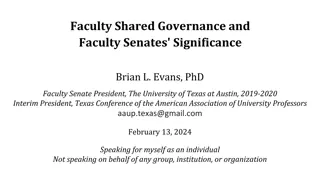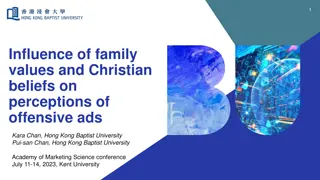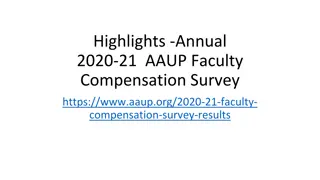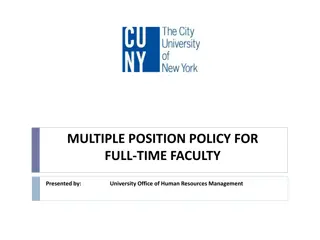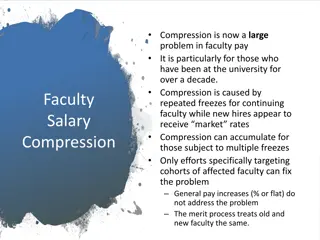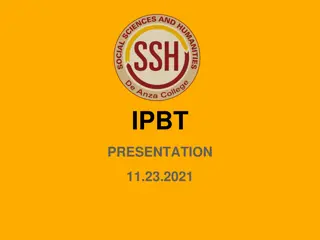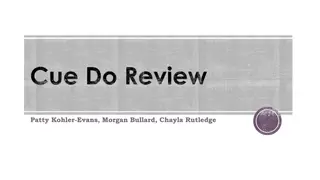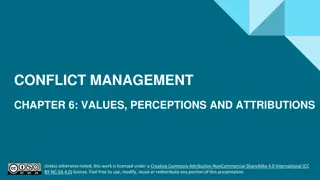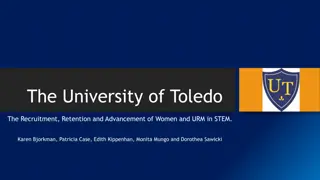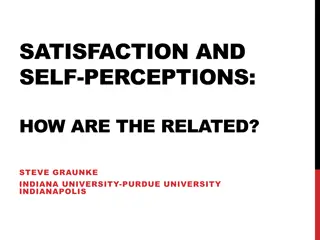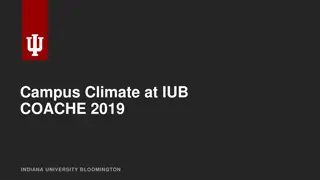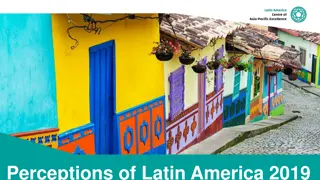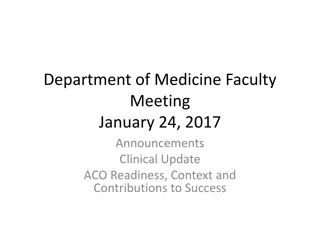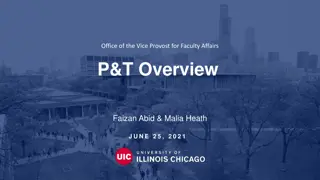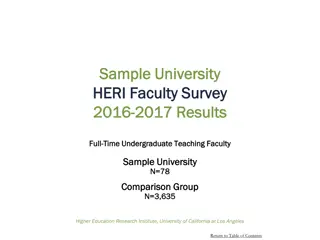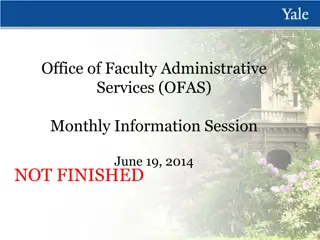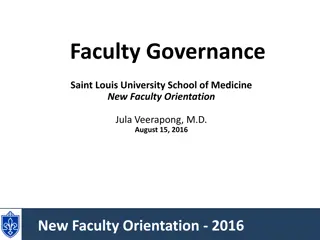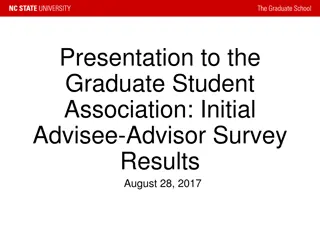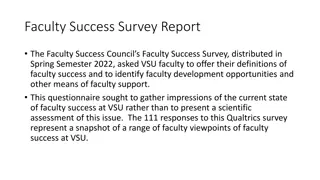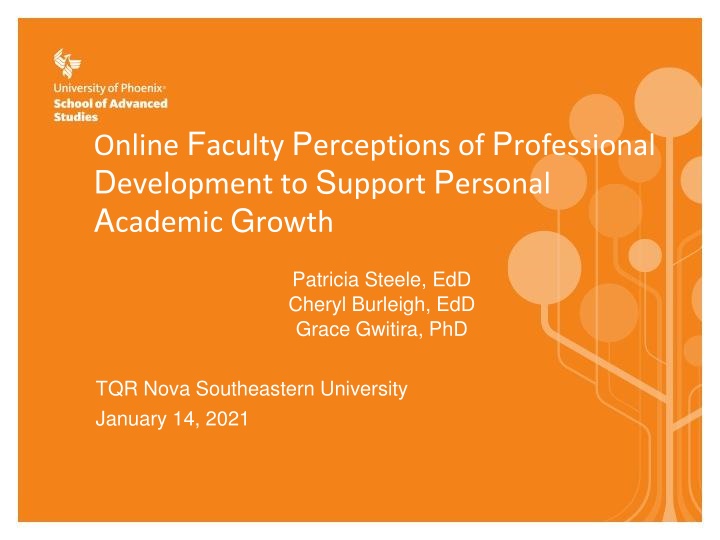
Exploring Online Faculty Perceptions of Professional Development
Discover how online faculty perceive professional development for personal academic growth, emphasizing the importance of assessing delivery modes and incorporating mobile technologies. The study aims to uncover expectations and experiences of online university faculty participating in professional development programs.
Download Presentation

Please find below an Image/Link to download the presentation.
The content on the website is provided AS IS for your information and personal use only. It may not be sold, licensed, or shared on other websites without obtaining consent from the author. If you encounter any issues during the download, it is possible that the publisher has removed the file from their server.
You are allowed to download the files provided on this website for personal or commercial use, subject to the condition that they are used lawfully. All files are the property of their respective owners.
The content on the website is provided AS IS for your information and personal use only. It may not be sold, licensed, or shared on other websites without obtaining consent from the author.
E N D
Presentation Transcript
Online Faculty Perceptions of Professional Development to Support Personal Academic Growth Patricia Steele, EdD Cheryl Burleigh, EdD Grace Gwitira, PhD TQR Nova Southeastern University January 14, 2021
Introduction Colleges and universities have various methods of delivering professional development (PD) training and education to their experienced faculty, including face to face courses. Studies suggested how to assess the effectiveness of PD courses, but a gap in the literature was found on a strategy or framework for assessing the mode of delivery of PD . Use of mobile technologies in PD in education has not been investigated and is overlooked. University Human Resource policies seldom, if ever, have set policies or frameworks addressing training and support for adjunct faculty. This research analyzed the effectiveness of PD programs along with clear descriptions of contextual factors.
Purpose Colleges and universities take various approaches to program design, technology delivery models, structural development, and quality of professional development programs. The lack of uniformity in approach means that across and within institutions various types of models are applied to PD programs creating inconsistencies that may not be helpful to their goals. An effective uniform professional development delivery framework could be used by colleges and universities to help them deliver consistent online professional development for faculty. The purpose of this study was to obtain online faculty members expectations, experiences, and perceptions of the professional development support offered at their respective online institutions.
Research Question RQ 1 What are the expectations of online university faculty when PD is delivered in an online format? RQ 2 What are the experiences of online university faculty when PD is delivered in an online format?
Significance Findings from this study could benefit online PD programs, which are not location or time specific, and may be beneficial given the need for social distancing necessitated by the current COVID-19 pandemic, also making them convenient (Setswe et al., 2019). Additionally, such programs could help to meet faculty s needs of self esteem and self- actualization, which may lead to increased job satisfaction and performance.
Theoretical Framework Knowles Andragogy. Andragogy is the "art and science of helping adults learn" (Loeng, 2018, p.4; Knowles, 1980, p. 43). Maslow s Theory. Five levels of human needs with the highest being self-actualization. Studio Thinking Framework (STF) and Habits of Mind (HoM) Develop craft, engage and persist, envision, express, observe, reflect, stretch and explore, and perfect a craft. The emphasis of HoM reveals a perspective that the goal of education is not predominantly just work, but a student who takes an engaged, attentive, creative, thoughtful, and skilled approach to work and working (Sheridan, 2009, p.73) and that they ought to be utilized in all areas of learning.
Method/Design Qualitative study used professional sampling through personal networking and communication. Data was collected through one-on-one interviews, both with semi-structure open-ended questions, using a checklist approach to group items into domains to ensure that the most important items from the research are reported (Buus & Perron, 2020). Interviews were audio recorded and thematic analysis used to review the data (Rahman et al., 2015). Descriptive quantitative data was acquired through a survey of questions related to key themes acquired during the one-on-one qualitative interviews (Gutterman & Mitchell, 2016).
Population and Sample Population: Members of Association for Educational Communications and Technology (AECT) Inclusion criteria: Self-defined online adjunct, part-time, or full-time faculty who work for a non-profit or for-profit university. Of the 82 total number of participants, 18 individuals were interviewed, and an additional 64 individuals completed the online survey.
Data Collection & Analysis Participant Interviews: Digitally recorded one-on-one interviews Transcribing Member Checking Online Survey: 41 Questions Multiple Choice Likert Scale Team Review of Interviews Cross checking process Consistency in coding Consistency in the identification of key content
Themes Communication and Collegiality Content Engagement Faculty and Student Needs Relevance in Content Self-Actualization
Participant Summaries A pseudonym was given to each participant to protect their identity. The following are a representative sample of the findings
Findings Communication and Collegiality You mean you want to hear what I want? That s great because at least I know someone is listening. First, as a faculty member I would like to be heard. Faculty have great ideas and suggestions to support meaningful PD for all faculty that is motivated to support students in their dreams of earning a higher education and degree. Faculty need to have a voice, and that there are faculty who are in the trenches daily with our students, who have a voice that matters. ~ Katy The main concern with PD, which I think my University does a great job of, is to listen to what faculty need and want. This shows faculty that the University really cares about us and values the contributions that we make in delivering course content and supporting student success. The other thing, that what is presented during the PD is appropriate for right now, are current, and we can immediately apply in our classes with our students. Also, faculty have the chance to network and engage with other faculty. This is important so that we know we are not alone as online faculty you sometimes feel that way. ~Delia
Findings Content The content needs to be up to date and the way it is delivered also differs from one training to the next. It looks the same and in some cases the questions are the same from one training to the next. How do I know? I keep a copy of the questions and my responses from the previous training. ~Bernie The content of the PD events must be those in which faculty can directly relate to, is new, and current. Much of the PD from the training seems to be the same, slightly updated but overall, its nothing to write home about. We need current and updated content that addresses real issues that faculty are experiencing now in the class with students. Maybe this is where webinars can be developed since those can be given often and those webinars must be current to support faculty and students. Also have faculty facilitate these webinars and same for taking a more active role in leading the trainings. Our faculty are very talented and should be able to take on these roles, not just lead faculty or program managers, real boots on the ground faculty. This is how the university can gain credibility with its faculty. ~Katy The content is well developed by the PD developers, program managers, and administrators. Everything is well thought out for the specific training, workshop, and webinars. Each of the events have current information that directly applies to support our students. ~ Lisa
Findings Engagement In a PD event, I want and expect to be engaged in the event. Engagement means there is interaction with participants and between participants, in real-time, not just asynchronously. I want and expect to learn information that is timely which I can then use immediately in the classroom or professionally. I want and expect that to be respected and have the ability to share opinions, ask questions, and obtain answers live during such events. ~Steve The PD is old and tired looking and there is no real faculty interaction. A few of the faculty who may know each other will respond to one another in the discussion posts. And the facilitator tries, but they are overwhelmed by the shear number of people in the workshop. To be active or want to be active in PD, there needs to be real-time engagement with faculty. The topics to be presented need to be current and relevant to faculty and translatable to the classroom. Also, I need to learn something that I didn t know before, maybe a new skill or technique or how to integrate technology into my classes. ~Bernie Faculty need opportunities to engage with other faculty, to interact in a live setting. That s how we share best practices and learn from one another. Asynchronous training is great for HR type of compliance, but for day-to-day type trainings, live is the way to go. Now if people cannot go to a live session, then record the session so others can listen later on. If they have questions or something to add, then they can correspond with a specific person. ~Katy
Findings Faculty and Student Needs The university needs to invest in developing new PD content. The only way this is going to happen is if the university listens to faculty and we have a voice. ~Consensus, FP Participants For PD to have meaning to me, not only do I need to learn something, a skill, or a new program, but I need to have content that is applicable today, that I can use right away or have access the minute I need it. In live trainings or webinars, the content does need to have a sense of urgency. ~Katy If I were to design a PD, I would do it how the University does. I would make sure there is engagement between faculty or opportunities to engage. I would make sure what is shared in PD sessions, webinars, and trainings is relevant and of interest to faculty. Most important, ask faculty what they would like to see. What are the things or skills they need in order to best serve students~ Missy Most important is that the information that is presented in a PD is current and directly related to the content and what our faculty and students need. Also, that faculty and leads who are supporting us listen to our feedback and then incorporate that feedback into the upcoming PD. Also, that the PD is sustained over time and that there is always engagement with faculty. What I like is that our opinions are requested and that we are really being listened to. ~ Anita The PD I need to see is based on supporting students who are feeling isolation, having difficult times, and are stressed based on COVID. I need strategies from the University and resources I can share to support these students. Same with Black Lives Matter. For some of our students they have been impacted by both events. The University needs to show that they care and provide faculty the resources needed to support our students. Again, this comes down to recognizing the problems currently happening in the world and then develop PD that is timely to deal with such occurrences.~Olive
Findings Relevance in Content Really it has to do with the information has to be just in time, relevant, and something that I can relate to, which will allow me to improve my teaching to assist students. Give faculty a platform to have their voices heard and acknowledged. ~Bernie Having guest speakers provide a different perspective as to what is available at the university and how to access that information. Plus, we can ask all types of questions. The speakers will share about specific resources that are available to faculty this includes assistive technology. ~Gretchen Most the training is to keep us up to date in how to teach our students. The recent workshops included a topic that was current and relevant, Innovations in Remote and Blended Classrooms. One of the questions that drove the workshop was How do we get that knowledge and that love of our topic area to our students, who will continue to grow with it in their own assignments and readings? The workshop looked at how to integrate technologies to further engagement of students in the class, even using Kahoot in this capacity and looking at other video conferencing features. ~Ajay
Findings Self-Actualization Oh, immensely. Each PD I have gone to, as I mentioned earlier, I have learned something. The skills and strategies learned from other faculty have made me rethink how to teach classes, get students engaged, and really listen to what my students need now. Also, I learn new strategies of how to deal with different issues that are happening right now that our students face and how I can better help them cope. ~ Ashlee I have enjoyed each of the PD experiences that I have been involved in. I always end a PD event excited that I met someone new, I learned something new, and I was able to share experiences with program managers that have the ear of the college, so my voice is heard. I do feel that my voice is heard, which makes me feel good. ~Delia I like the variety of training, especially now with a focus on students and how they are doing in the midst of COVID. Continue the focus on faculty and student mental health. I also like the blogs on PD. The University is not afraid to direct us to other places that have great PD available.~ Ajay
Discussion Faculty at Non-Profit Institutions Faculty at For-Profit Institutions Positive Experience Negative Experience Live Sessions, Synchronous Asynchronous Valued Less Valued Transparency Less Transparent Voices Heard, Input Welcomed, Treated as Professionals Voices Stifled, Not Heard, Just Employees PD not driven by policies Policy Driven Current, Faculty & Student Driven Old, Recycled,, Not Current PD Adds to Teaching, Not completely reliant on outside PD PD Not Value Added, Relies on Outside PD
Contributions Findings from this study could benefit online PD programs, which are not location or time specific, and may be beneficial given the need for social distancing necessitated by the current COVID-19 pandemic Effective PD programs could help to meet faculty s needs of self esteem and self- actualization, which may lead to increased job satisfaction and performance.
Recommendations Stealthy, Current, and Relevant PD Higher education institutions need to pivot in times of crises to support faculty Listen to faculty, they have the best interests of their students and institutions at heart Acknowledge faculty on a regular basis Pulse checks by university administration, check in with faculty
Questions Any further questions can be directed to the team Dr. Patty Steele steelep@email.phoenix.edu patriciasteele.steele@gmail.com
References Baran, E., & Correia, A. P. (2014). A professional development framework for online teaching. Tech Trends, 58, 95 101 (2014). https://doi.org/10.1007/s11528-014-0791-0 Bartle, M. S. (2013). Andragogy. Research Starters: Education (Online Edition) Buus, N., & Perron, A. (2020). The quality of quality criteria: Replicating the development of the Consolidated Criteria for Reporting Qualitative Research (COREQ). International Journal of Nursing Studies, 102, 103452. https://doi.org/10.1016/j.ijnurstu.2019.103452 Dailey-Hebert, A., Norris, V. R., Mandernach, B. J., & Donnelli-Sallee, E. (2014). Expectations, motivations, and barriers to professional development: Perspectives from adjunct instructors teaching online. The Journal of Faculty Development, 28(1), 67-82. Gutterman, T. C. & Mitchell, N. (2016), The role of leadership and culture in creating meaningful awareness: A mixed method case study: Innovations in Higher Education, 41, 43-57. DOI 10.1007/s10755-015-9330-y Knowles, M.S. (1980). Modern practice of adult education: Andragogy vs.Pedagogy. Follett. (Original work published 1970). Loeng, S. (2018). Various ways of understanding the concept of andragogy. Cogent Education, 5(1), 1. https://doi.org/10.1080/2331186X.2018.1496643 Maslow , A. H. ( 1943 ). A theory of human motivation. Psychological Review, 50 ( 4 ), 370 396 . http://psychclassics.yorku.ca/Maslow/motivation.htm Merriam, S. B. (2001). Andragogy and Self-Directed Learning: Pillars of Adult Learning Theory. New Directions for Adult & Continuing Education, 2001(89), 3.https://doi.org/10.1002/ace.3 Rahman, M., Khan, R., & Mashaddi, S. (2019). Social accountability of a medical college in Pakistan - A case study. Pakistan Armed Forces Medical Journal, 69(4), 735-41. https://www.pafmj.org/index.php/PAFMJ/article/view/3191 Schulte, M. (2018). Adult learning degree and career pathways: Allusions to Maslow s hierarchy of needs. Journal of Continuing Higher Education, 66(1), 62 64. Setswe, G., Madiope, M., & Makoe, M. (2019). The Use of Mobile Learning Technologies for the Professional Development of Academics at a University of Technology. Proceedings of the European Conference on Research Methods for Business & Management Studies, 378 385. https://doi.org/10.34190/RM.19.098 Sheridan, K. (2009). Studio thinking in early childhood. In M. Narey (ed.). Making Meaning Arts-based Early Childhood Education Constructing Multimodal Perspectives of Language, Literacy, and Learning through Arts-based Early Childhood Education. (pp. 71-90). Springer http://digilib.stiem.ac.id:8080/jspui/bitstream/123456789/370/1/%5BMarilyn_Narey%5D_Making_Meaning_Constructing_Mult%28BookFi.org%29.pdf#page=78 Steele, P., Burleigh, C., Bailey, L., & Kroposki, M. (2019). Studio Thinking Framework in Higher Education: Exploring Options for Shaping Immersive Experience Across Virtual/Augmented Reality Curricula. Journal of Educational Systems Technology, 0(0), 1-24. DOI: 10.1177/0047239519884897

